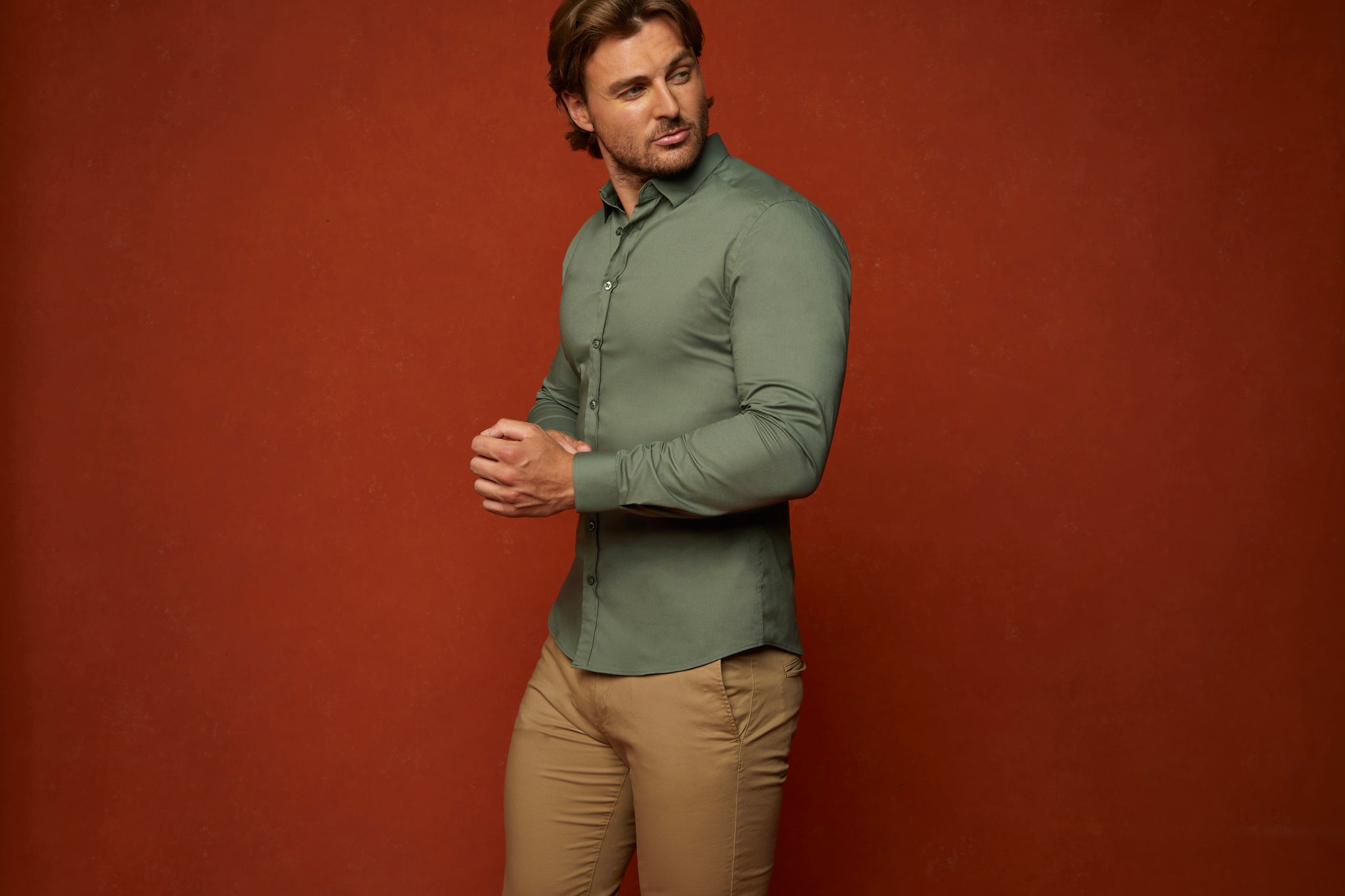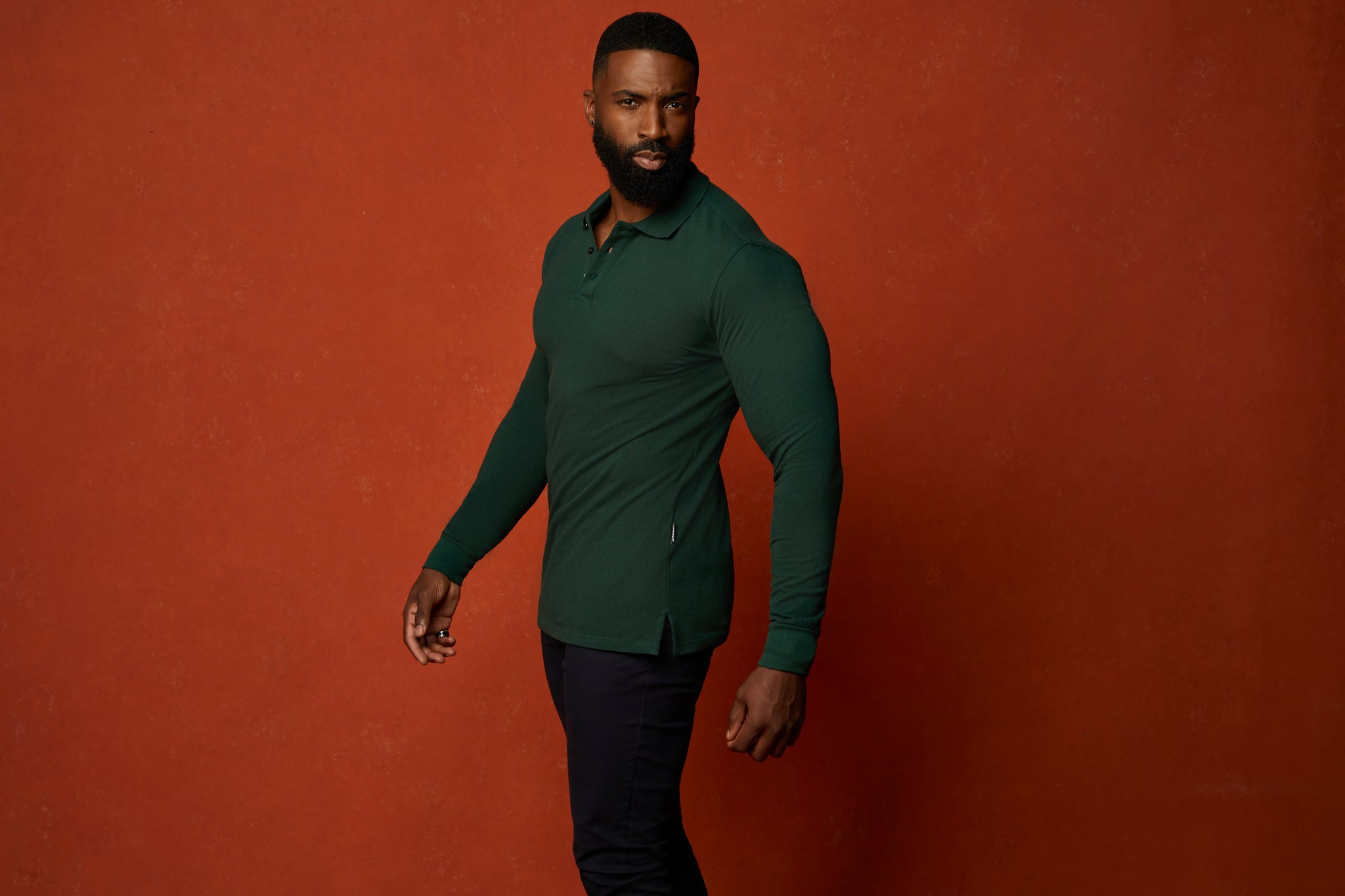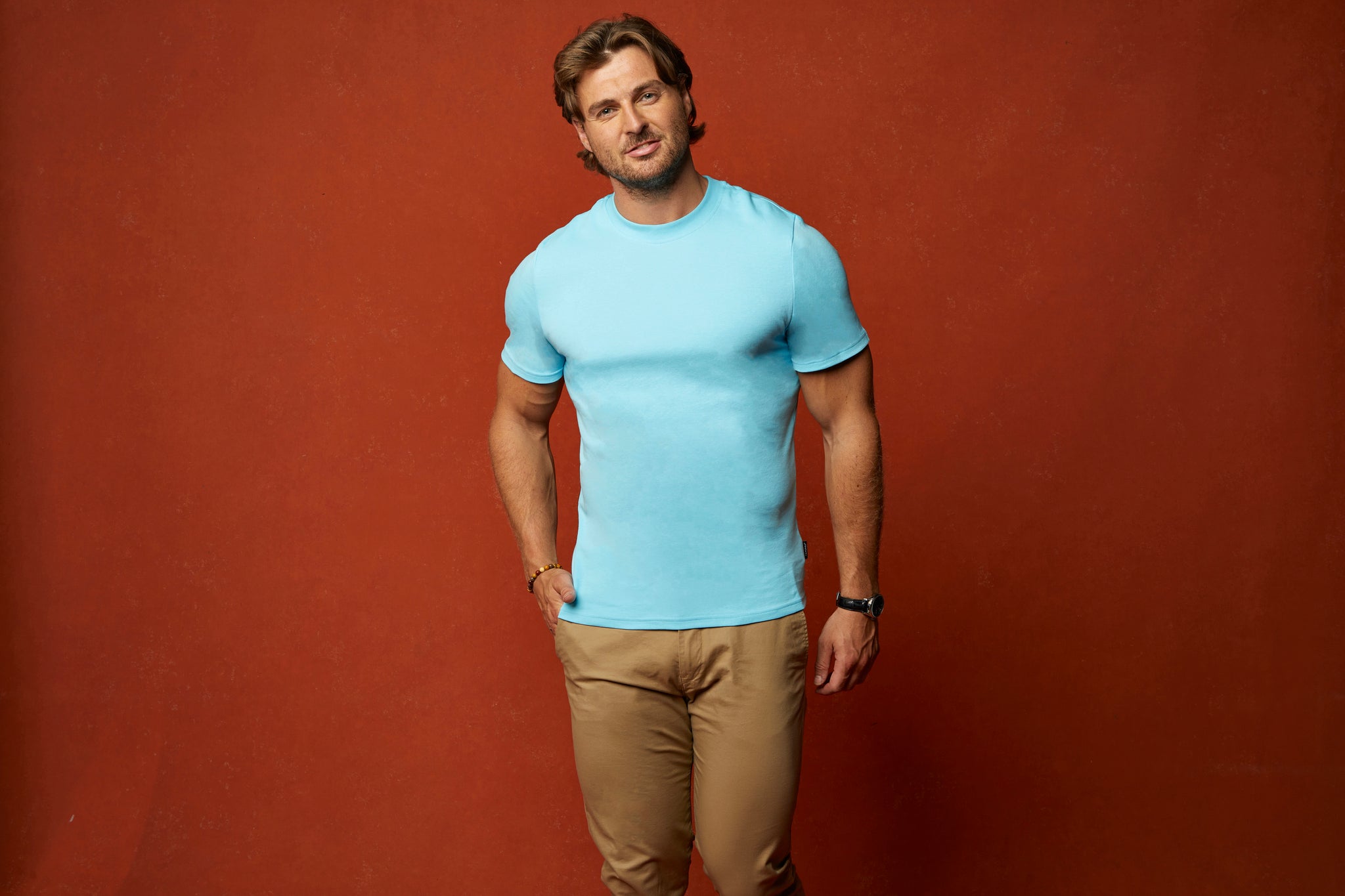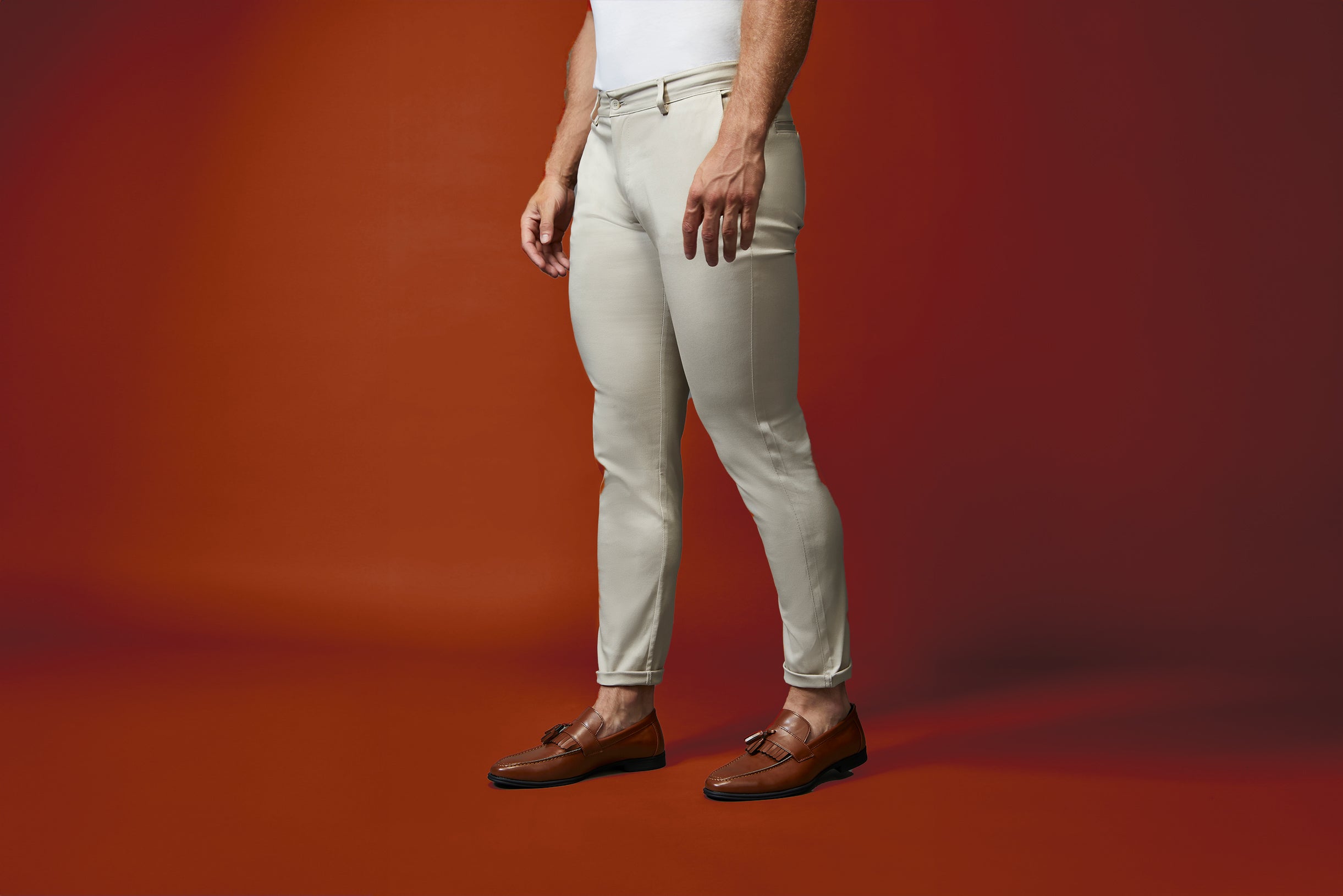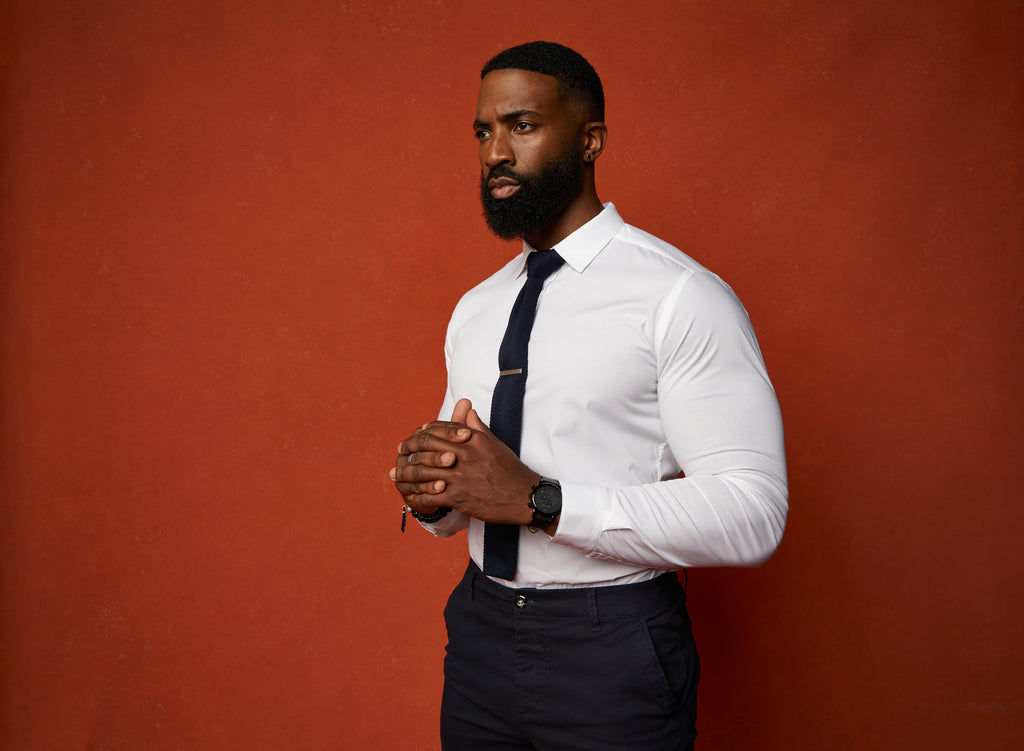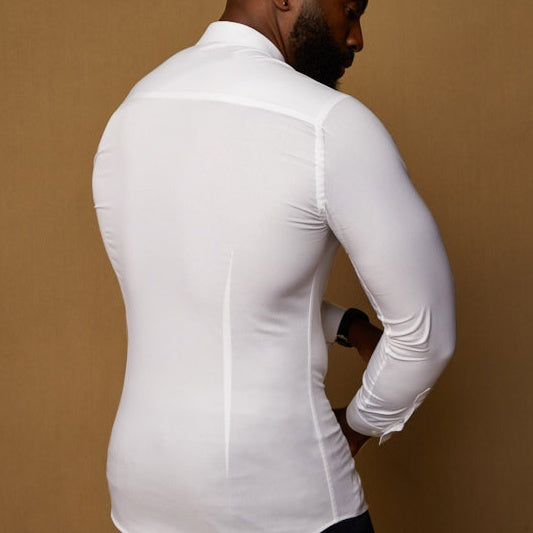Dressing to impress is about more than just throwing on formal clothes.
You could be wearing the most expensive shirt in the world but if the fit is off, it won’t do you any favours. That’s where skinny fit shirts come into play. In this blog we will look at the difference between a loose shirt and tight shirt.
The main difference between loose shirt vs tight fit shirt is down to your preference. This fit can be based on the collar size but also the chest size, if the collar is too tight it will impact the overall look of your shirt, you should be able to move your neck freely.
Same with the chest fit, this needs to be fitted but not loose, avoiding any button gaping at the front. Looking for dress shirts that fit your body correctly?
Check out our collection of fitted shirts here.
Of course, balancing all the elements of a dress shirt’s fit is almost impossible when buying off-the-rack items. They’re made for the masses, meaning they fit almost no one properly.
Here at Tapered with the introduction of our own muscle fit shirts, we believe in the power of well-fitting clothes and the difference this makes to your overall look.
We’re here with the key facts on how to choose the best-fitting men’s dress shirt so you can look sharp anytime, anywhere.
Should a Shirt be Tight or Loose?
The easiest way to explain whether a shirt should be tight or loose is to break the fit down into its main components.
Some are more important than others when choosing the right shirt and it all really depends on which areas of your body you’re trying to highlight.
How a Shirt Should Fit
So, here’s a rundown on how to choose the right fit for each area of a dress shirt.
The Collar
We’ll start at the top of the shirt with the collar. When buying a dress shirt in a shop, this is usually how you determine size. While t-shirts come in small to large (and so on), dress shirts are measured in collar size.
You probably already know this, but we measure collar size in inches. The number refers to the length from the buttonhole to the button when you lay the shirt flat.
In a shop with a large size range, you’ll typically find dress shirts from 14” to 19”. Choosing the best fitting shirt should be easy then, right?
Well, unfortunately not, particularly if you’re more of an athletic fit. Often, what appears to be the right neck size will result in sleeves that are the wrong length and an ill-fitting chest.
The correct size for a shirt collar is if you can fit two fingers inside it when buttoned up. You can play around with the size a little if you’re not wearing a tie, as you’ll have a bit more room with the collar unbuttoned.
The Yoke and Chest
The yoke is the back panel on a dress shirt between the sleeves. The horizontal seam across the top of the shirt should be just longer than your shoulders so you have a bit of extra room for movement.
You’ll know if it’s the wrong size because you either won’t be able to move your arms or you’ll have too much extra material.
As you can imagine, the chest is a difficult part to fit on typical shirts when you’re an athletic build. Ideally, your chest should fill the shirt out so you can see your pecs through the material.
Note, we don't mean a see-through shirt but that you have a defined chest area.
How to Tell if a Shirt is Too Small
When is a shirt too small? a tell tale sign is the chest and shoulders. The proper fit around the chest and shoulders should feel snug but should still give you a full range of movement. If the fabric pulls on the shirt’s buttons when you’re stood up or sat down, it’s too small.
The Armholes
The armholes on a dress shirt are a common sticking point for almost every man, regardless of body type. Most commercial brands cut the armholes too big to accommodate guys with bigger arms.
This means it’s almost impossible to match your required arm size with the other areas on a shirt.
The best fit for the armholes of a dress shirt is as small as possible, ideally with a tapered feel under your arm. However, you should still be able to move your arms freely.
If the armholes are too small, you’ll feel restricted. Also, every time you move, you’ll pull the shirt out of your waistband (which isn’t a great look).
But, if the armholes are too big, you often end up with material puddling around your waistline – again, not a good look. You’ll also notice problems if you decide to wear a jacket.
The material will bunch up in your armpit, which is both uncomfortable and unattractive.
Sleeves
You probably already know the difficulties associated with shirt sleeves. While you want them to be tight enough to show off your biceps, but not very tight where it often restricts movement and means the rest of the shirt is too small.
But, most brands make their shirt sleeves really baggy for the same reason they make the armholes large. Baggy sleeves are undesirable regardless of your body type, as they make you look much bigger than you are (and not in a good way).
The perfect sleeve is one that hugs your arm to create definition but still allows you to reach forwards without pulling on the fabric. The cuff should sit somewhere between your wrist and the base of your thumb, depending on preference.
For example, if you wear a watch, you’ll either need sleeves that are baggy enough to cover it or sleeves short enough to sit above it.
The Body
Typical men’s dress shirts have a straight body. If you’re buying for a large chest, this means you’ll have lots of excess material around the waist. We all know how unflattering this looks.
Men (should) have a V-shaped torso with a noticeable difference between their chest and waist measurements. This is called the drop. For example, a man with a 42” chest and a 34” waist would have an 8” drop.
Good luck finding a commercial shirt that accommodates a drop. Your only real hope for an off-the-rack shirt with a drop is a slim-fitting one, but these lack in the arm and chest areas.
The ideal fit for a shirt body is one that goes in at the waist but is wide enough to be tucked in comfortably. As mentioned, most standard shirts have a straight body, which makes them look wide and billowy at the bottom.
The Length and Seat
The seat refers to the horizontal measurement across the shirt’s bottom hem. Most shirts have a rounded bottom, so you measure the seat at the straight point above this where the seam ends.
Ideally, a well-fitting men’s shirt is slightly wider in the seat than in the waist. This is to compensate for the extra material needed for when you sit down. But, as we already know, you won’t find this kind of variation in a typical commercial shirt.
So, if you want something narrow in the waist, your options are to buy a small shirt and leave the bottom buttons undone or to not tuck it in. As the latter might not be an option, you’re quite limited in getting the right fit in this area.
But what about the length? This is a difficult one and depends on several factors. While not everyone wears a dress shirt tucked in, that’s how we’ll think of them here because it’s the “correct” way to wear them.
When untucked, the bottom of the shirt should fall in line with the bottom of your trouser pockets. This is on formal trousers, as most people wear jeans lower. Basically, the shirt’s tail should cover most of your bum.
Should a Shirt be Tight?
It’s great talking about the how a shirt should fit, but more importantly; how do we establish whether it should be loose fitting shirt or tight?
Typically it depends on preference but in general you want to find the right balance between fitted and tight. In doing this a good option is to buy a standard shirt off the rack and take it to a tailor.
A tailor can adjust it to suit your body by putting darts in the back or adjusting seams. However, they can’t make areas bigger, so you’ll usually have to buy a shirt that’s too big and basically get every measurement adjusted.
While owning a tailored shirt is great, it becomes very expensive to do this with every item you buy.
The next option is to adjust the fit you buy. For example, a slim-fitting shirt will hug where you want it to and will mean there’s less excess material.
But, this isn’t a great option for athletic guys who need it wide in some places and narrow in others.
How Tight Should a Guys Shirt Be?
We've already gone into detail on how a shirt should fit in each part of your body but how tight should you go with your shirts? How tight is too tight?
A good rule of thumb for how tight your shirt should be is that you can pinch 1-2 inches of fabric on any particular area.
This is the absolute minimum, if you cant pinch less than an inch of fabric in any part of the garment on your body it's likely too tight.
Is My Shirt Too Tight?
A common thing to look out for in your shirt being too tight is the front buttons. If there is any sort of gape between the 2nd or 3rd button its definitely too tight in the chest.
Often when guys size down in order to get the shirt to fit, the first sign that the shirt is poorly fitting is a gape at the front buttons - avoid this at all costs!
Baggy Clothes vs Fitted Clothes
Baggy clothes can offer a laid-back, comfortable aesthetic, ideal for casual settings or layering. They allow for greater freedom of movement and can hide certain body features if that's your preference. However, they can sometimes appear sloppy if not styled correctly.
Fitted clothes, conversely, enhance your silhouette by conforming to your body's shape, projecting a more polished and tailored look. This can boost confidence and is particularly suited for professional or formal environments. Striking a balance between the two can help you adapt to different occasions with style and ease.
Tight Fitting Shirt
The best option, of course, is to invest in a Tapered Muscle Fit Shirt. We design our shirts for slim and athletic men or bodybuilders who want to show off their hard work through a tight fitting shirt but not spray on.
We’ve added in loads of great features that are perfect for men with more muscular builds, such as:
- Enhanced darts in the back
- V-taper design – narrow waist, wide chest
- 4-way stretch cotton
In short, our shirts fit close to the body but still allow for full movement. We chose our proportions carefully so you have space in the chest and arms but the right taper in the waist.
They look great tucked and untucked and are ideal for both formal and smart-casual looks. Whether you pair them with jeans or smart trousers, you can’t go wrong with a Tapered Dress Shirt.
Check out our best seller here
Do tight shirts make you look smaller?
If you have the right physique then tight shirts do not make you look smaller. in fact they have the opposite effect and make you look bigger by enhancing your muscles!
If however you are very slender then a tight dress shirt will also accentuate this, so on this occasion it is best to go slightly looser fitting shirt if you are self conscious about your size.
If you’re tired of losing yourself in ill-fitting shirts or being restricted by really tight shirts, give our Tapered Dress Shirts a try. We offer a wide range of colours and fits and it won’t take you long to find out why so many men love them.
Our revolutionary cut provides a 10" drop from chest to waist.
Fully fitted in chest and shoulders whilst tapering sharply down, giving a tailored look. No more bagginess in the waist.
Enhanced Darts
Expertly tailored darts at the back, for the perfect fit.
Stretch Cotton
Super soft, breathable and allows complete freedom of movement.
Perfect for the office.
With our non obtrusive logo stitched subtly on the wrist makes our TAPERED Fit Shirt ideal for formal occasions.
Tapered Fit Shirts are the true solution to your shirt fitting problem. If you want a shirt that fits your body like it should, check out or best selling shirt here




